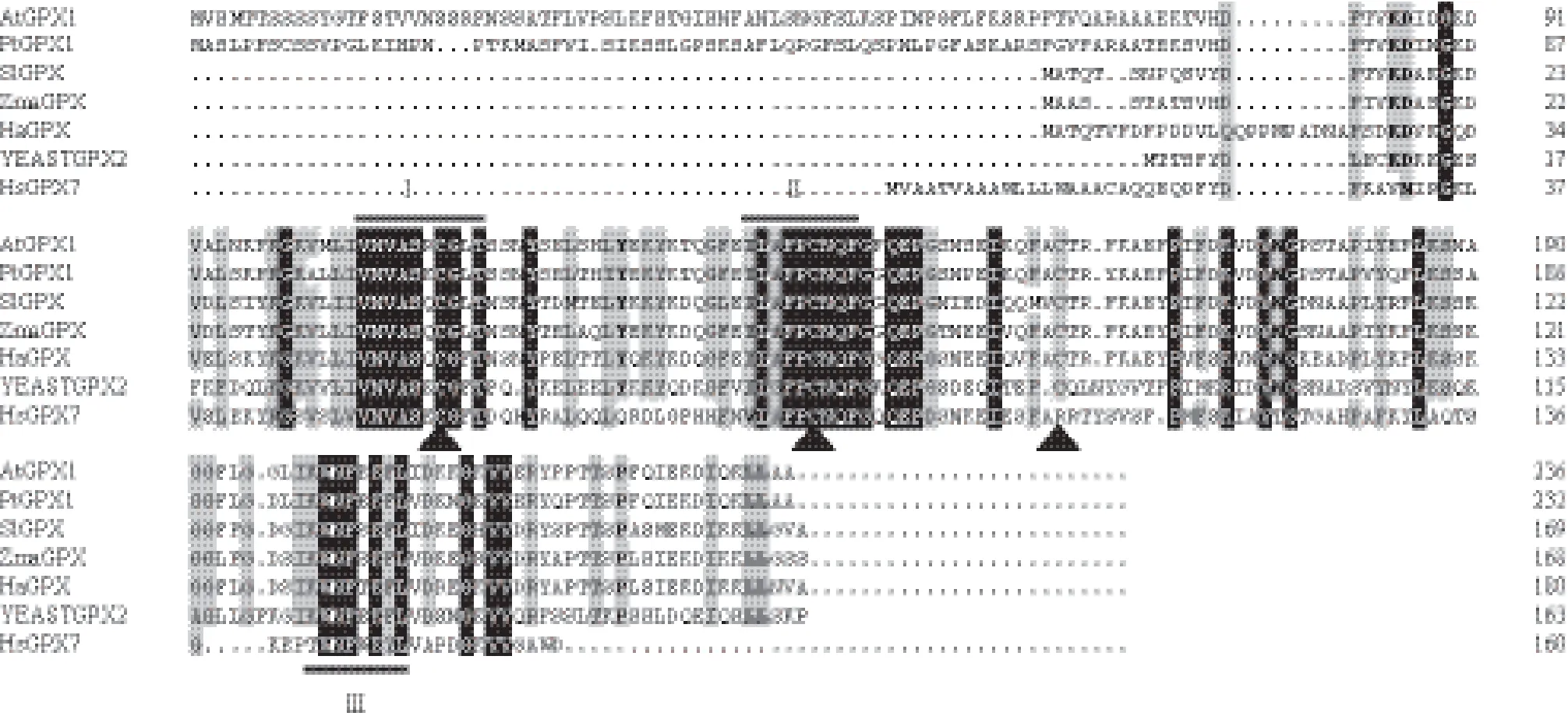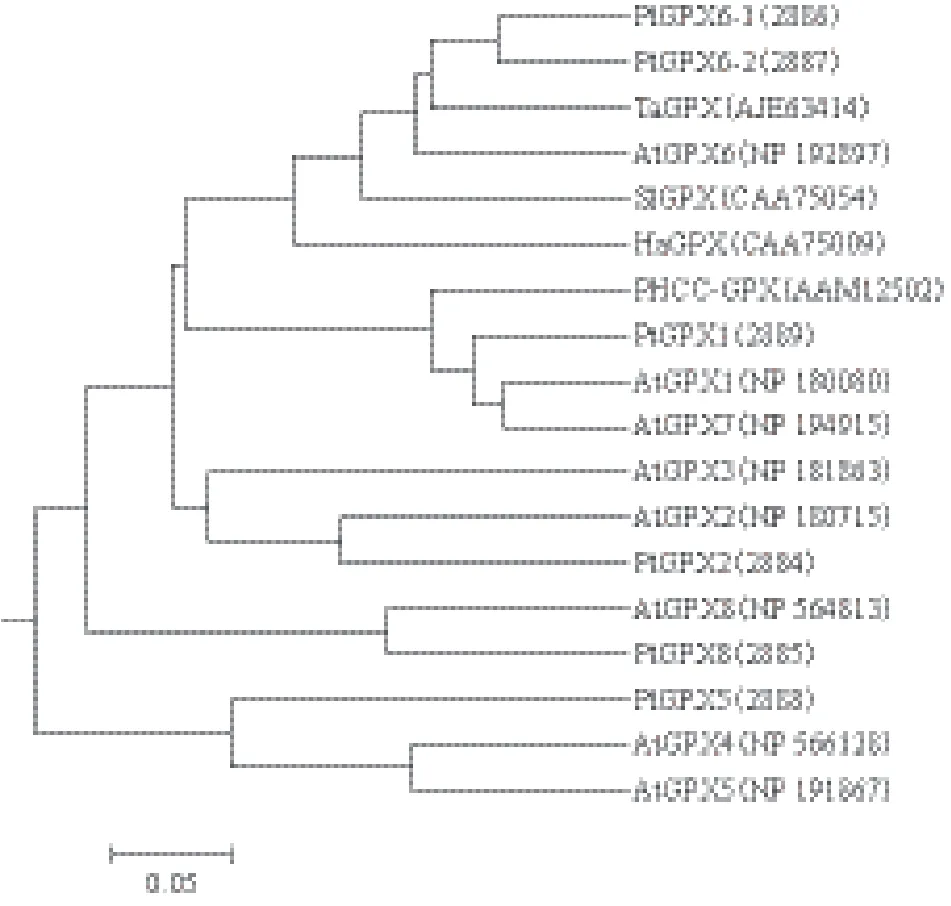植物谷胱甘肽过氧化物酶(GPX)研究进展
2016-06-13乔新荣张继英
乔新荣 张继英
(信阳农林学院,信阳 464000)
植物谷胱甘肽过氧化物酶(GPX)研究进展
乔新荣 张继英
(信阳农林学院,信阳 464000)
逆境胁迫会诱导植物产生过多的活性氧(ROS),引起氧化胁迫,严重影响其生长发育。相应地,植物为适应诸多不良环境会产生多种抗氧化剂、抗氧化酶等协调氧化还原平衡,其中谷胱甘肽过氧化物酶(glutathione peroxidase,GPX)是植物体内重要的抗氧化酶之一。对近年来植物中GPX的结构、亚细胞定位、酶催化底物特点及作用研究进展进行综述,并对未来可能的研究方向进行展望。
谷胱甘肽过氧化物酶;硫氧还蛋白;胁迫耐性
GPX(EC 1.11.1.9,EC1.11.12)是一种含巯基的过氧化物酶,可以清除机体内的H2O2、有机氢过氧化物及脂质过氧化物,阻断ROS自由基对机体的进一步损伤[6,7]。人们对GPX的认识及功能机理的研究,最早从动物开始,1957年提取哺乳动物红细胞中的酶试验H2O2反应时发现的[8]。根据氨基酸序列、底物特异性及组织定位,目前把哺乳动物中的GPX同工酶分为八大类,即GPX1-8。其中GPX1-3、GPX5和GPX6是同源四聚体;GPX4(磷脂GPX,PHGPX)、GPX7、GPX8是单体[7,9]。GPX1-4的催化活性位点含硒代半胱氨酸(SeCys)残基[7,9-11],另外,人及猪的嗅觉上皮细胞中的GPX6的催化活性位点也含SeCys残基[12],其余类别的催化活性位点由Cys残基替代SeCys残基[7,9]。SeCys由密码子UGA所编码,而UGA在生物系统中是一个蛋白合成终止信号,其识别需要特殊的机制。SeCys被认为是第21个基本氨基酸[11]。
由于哺乳动物中的GPX利用谷胱甘肽(GSH)为电子供体还原H2O2及有机氢过氧化物等过氧化物,故GPX名称由此而来。人们对植物GPX的研究开始较晚,第一个植物GPX基因分离于烟草的叶片中,其cDNA与动物的GPX有较高同源性[13],随后从拟南芥[14]、水稻[15]、番茄[16]、柑桔[17]、菠菜[18]、盐芥[19]等多种植物中分离和鉴定。本文对近年来植物中的GPX蛋白的结构、亚细胞定位、作用底物及在胁迫反应、生长发育中的作用等研究进展进行综述,旨在为植物GPX功能机制的深入研究奠定基础。

图1 部分植物、动物及微生物的GPX氨基酸序列比对
1 植物GPX 结构及定位
植物GPX与动物GPX4/PHGPX 氨基酸序列高度同源,定点突变技术研究表明动物SeCys-GPX活性高于Cys-GPX 2-3个数量级[20]。而植物 GPX的催化活性位点含Cys残基,而不含SeCys残基,且其活性位点Cys残基替换为SeCys残基时,以GSH为还原底物的酶活性并没有显著增加[21],因此人们一度曾质疑Cys-GPX是否具有过氧化物酶活性。后来的研究发现,当GPX的电子供体是硫氧还蛋 白(thioredoxin,Trx)或具有CXXC基元的蛋白,而非GSH时,检测到了Cys-GPX具有较强的活性[22,23],这类底物在非脊椎生物、绿色植物、细菌及真菌中普遍存在。因此植物GPX实际上是依赖Trx的过氧化物酶[24]。所以以最初发现GSH为底物命名的GPX一词,对于GPX家族中的大多数成员来说是不合适的,但人们习惯上仍使用GPX。
生物GPX蛋白序列高度相似,从GenBank及PeroxiB ase数据库选取部分植物、动物及微生物的GPX蛋白序列进行比对(图1) 发现,所有物种的GPX domain 具有较高的相似性,从N端依次含有3个保守的结构域,VNVAS(K/R/Q/E)CGLT、LAFPCNQF 和KWNF(E /T /A/S)KFLV。且GPX同工酶含有3个保守Cys残基催化位点,其中前两个分别位于第Ⅰ,第Ⅱ结构域内,第三 个位于结构域外(图1的黑三角),一些研究已证明植物依赖Trx的GPX的催化作用分3步,首先GPX保守的第一Cys残基催化H2O2或有机氢过氧化物产生 H2O或乙醇,同时生成次磺酸Cys-SOH,然后Cys-SOH和第三个Cys残基形成分子内二硫键,最后在Trx还原酶及NADPH作用下,二硫键被Trx还原[22,25,26]。与植物相比较,哺乳动物的前两个结构域内的催化位点分别是2个Cys残基或一个Cys残基和SeCys残基,第三个催化位点是Gly、Trp或Gln[22]。到目前为止,分离鉴定的植物GPX中,除杨树(Populus trichocarpa)GPX通过疏水作用以同源二聚体形式存在外[27],其他都是单体。
模式植物拟南芥GPX家族有8个成员,其氨 基 酸 数 量 在169和236之 间, 研 究 表 明AtGPX1,-2,-5 和 -6,8蛋白体外表达后只利用Trx为电子供体,还原H2O2和有机氢过氧化物,且还原H2O2的活性较高[25,28]。从大白菜中 分离的GPX编码的蛋白也有相同的特点[26]。从杨树中分离的6个GPX同工酶也仅以Trx为电子供体,但还原H2O2及有机氢过氧化物的活性并无差别[22]。向日葵,番茄中的GPX既可利用GSH,也利用Trx为电子供体,体外原核表达后,利用GSH可以还原烷基类、脂酸和磷脂等有机氢过氧化物,但不还原H2O2,而利用Trx为电子供体时,上述过氧化物都会还原[24]。从盐胁迫小麦幼苗的转录组中分离的GPX基因所编码的蛋白质,也可利用GSH和Trx为电子供体,还原H2O2和有机氢过氧化物[29]。这些研究表明了植物Trx-GPX在底物亲和性及催化效率方面要高于GSHGPX。因此,植物GPX更偏向利用Trx为还原剂。从GenBank及PeroxiBase 数据库中下载上述的GPX蛋白的氨基酸序列,构建了系统进化树(图2), 分析表明进化距离相当的不同物种,其GPX活性以及利用的还原底物种类也有所不同,如拟南芥AtGPX2和杨树PtGPX2、拟南芥AtGPX6和番茄SlGPX。
Trx也广泛存在于高等植物细胞的胞质、质膜、内质网、细胞核、线粒体和叶绿体中[30,31]。不同亚细胞来源的电子供体Trx也有对其靶酶的高度特异性特点。研究表明AtGPX无法利用拟南芥的2个胞质Trx h2和h3还原过氧化物[31]。分别来自杨树和拟南芥线粒体的P tTrxh2和AtTrxo1不能作为杨树GPX同工酶的 电子供体,而来自胞质的Trx亚型PtTrxh1和PtTrxh3可以作为杨树GPX同工酶的电子供体[30]。
植物GPX同工酶广泛存在于不同组织、不同器官、不同的发育阶段以及细胞的不同部位[32-34],与ROS遍布于细胞的各个部位相一致。人们对模式植物拟南芥AtGPX家族成员的细胞定位进行了研究,系统进化树分析揭示AtGPX1和AtGPX7、AtGPX4和AtGPX5这2对蛋白质彼此之间高度相似(图2),AtGPX6和AtGPX8也高度相似[3,35]。AtGPX1和AtGPX7定位于叶绿体,蛋白质组学研究表明AtGPX1定位在叶绿体类囊体膜上[36,37]和叶绿体基质中[38],而AtGPX7在叶绿体精确分布还不清楚。利用生物信息学分析显示,AtGPX3是跨膜蛋白,定位于高尔基体、胞质、内体(endosome)和线粒体等细胞器,其170个氨基酸在膜外(http://www. arabidopsis.org/),实验仅证明GFP-AtGPX3位于胞质[39]。洋葱 GFP-AtGPX8实验表明,AtGPX8位于胞质和细胞核中,但大部分位于胞质中[28]。从推断的氨基酸序列及信号肽预测AtGPX2、AtGPX4及AtGPX6定位于胞质,AtGPX5定位于内质网[3],而Margis等[7]进行系统进化分析揭示AtGPX2位于内质网/胞质,AtGPX4和 AtGPX5 是胞质同工酶,AtGPX6定位在线粒体。这些利用生物信息学的预测结果不一致性,进一步揭示了GPX作用机制的复杂性,需要实验去进行证实每一种GPX在细胞中的真实存在位置,更深入阐释其作用机理。

图2 部分植物GPX的系统进化分析
2 植物GPX功能
2.1 GPX调节植物胁迫耐性
当植物遭受病原菌入侵[13]、高盐[17,40-42]、重金属[18]、机械刺激[16]、干旱[43]、温度及光照[15,42]等不同生物、非生物胁迫时,多数GPX的表达及活性会增强。但也有表达活性降低的情况,例如,在渗透或甲基紫精诱导胁迫条件下,大麦(Hordeum vulgare)的2个GPX同工酶活性增强,而第3个同工酶(HvGPX3)的活性下调[44]。
目前,通过利用植物转基因技术增加或降低GPX表达量,对植物 GPX的生物学功能已进行了广泛研究。Gaber 等[28]利用AtGPX8 的超表达株系和基因敲除突变体材料,通过百草枯胁迫处理,证明AtGPX8参与胁迫耐性,并具有清除ROS和阻止DNA损伤作用。Zhai等[29]分离的定位于叶绿体的2个小麦GPX基因,将其转入拟南芥超表达后,表现出对盐、H2O2和ABA胁迫的强耐性。在冷胁迫下,超表达番茄GPX转基因植株表现出较高的光合速率和果糖-1,6-二磷酸活性[45],且对非生物胁迫(机械刺激)的耐性也增强[46]。超表达烟草GPX基因后,其转基因烟草增强了ROS清除能力,细胞膜损伤缓解,也增强了盐和冷耐性[47]。在烟草的细胞质中或叶绿体中超表达衣 藻(Chlamydomonas)GPX 后,转基因株系都表现较高的光合能力,抑制了脂质氢过氧化物的产生,增强了盐、冷等胁迫的耐受性[48]。
经深入研究揭示,植物GPX参与胁迫耐性,实质上是GPX参与调节细胞氧化还原信号转导。Miao等[39]的研究表明拟南芥 AtGPX3通过H2O2调节氧化还原状态,并作为氧化还原转导子,AtGPX3和磷脂酶ABI1/ABI2互作,激活质膜 Ca2+和 K+通道,关闭气孔,参与ABA和干旱胁迫信号路径。Chang等[35]利用位于拟南芥叶绿体的AtGPX1和AtGPX7总的无义转基因株系AS-cpGPX 及Atgpx7突变体材料研究发现,强光胁迫下,AtGPX1负责光氧化胁迫下H2O2的还原,AtGPX1与AtGPX7的功能并不完全冗余,且AS-cpGPX 株系的Cu/Zn-SOD 和Mn-SOD活性降低,表明叶绿体GPX与SOD共同调节叶绿体中.O2-和H2O2的平衡。另据报道,在拟南芥中超表达小麦GPX后,其转基因植株中参与盐、H2O2和ABA信号路径中的关键调节子(SOS1、RbohD、ABI1/ABI2)基因的表达水平也发生了变化[29]。
2.2 GPX与激素信号的交联
植物GPX调节激素信号转导,例如,在拟南芥中超表达的2个小麦GPX 基因,ABA 处理后,改变了ABA信号通路中的蛋白磷酸酶2C(PP2C)型ABI1、ABI2基因的表达水平,而且该转基因株系的种子对ABA不敏感,表明GPX负调节ABA介导的抑制种子萌发[29]。通过AtGPX基因突变体的生长分析,gpx1、gpx4和gpx7 中,生长素处理显著增加了侧根密度,人工合成激素独脚金内酯GR24以及ABA降低了侧根密度,从而证实GPX在激素介导调节侧根发育中起重要作用[49]。AtGPX3和ABA信号通路中ABI2/ABI1生理互作,参与ABA介导的气孔调节[39]。同时,激素也参与调节 GPX基因的表达。已报道,AtGPX8 的转录水平在ABA、生长素(IAA)、水杨酸(SA)、茉莉酸甲酯(MeJA)等不同的激素诱导下增加,表明这些激素参与AtGPX8的基因表达调节[28]。
2.3 GPX参与植物的生长发育
除上述一些植物GPX通过激素调节生长发育外,有的植物GPX直接调节生长发育。例如,通过利用Ac/Ds 转座子系统进行大规模的插入突变体筛选方法,已证明AtGPX5是一个雌性配子体发育相关的基因[50]。水稻线粒体OsGPX3基因沉默导致其丧失了正常的植物生长发育,该突变体表现根短,株型矮小[51]。Atgpx7 突变体在短日照条件下莲座叶直径大于WT,长日照条件下叶片数量也高于WT,表明AtGPX7参与苗期生长发育[49]。在拟南芥中超表达小麦GPX基因后,该转基因株系增加了盐胁迫条件下种子的萌发率,促进了幼苗的生长[26]。综合分析,GPX可能调节依赖ROS的发育及代谢信号,这些信号会改变植物生长分化相关过程。
此外,植物GPX也参与细胞程序性死亡(PCD)。Bax蛋白是细胞凋亡的诱导子,研究表明烟草中表达番茄GPX抑制了盐、热激、Bax蛋白诱导细胞死亡,从而保护植物组织免受多种胁迫[52]。
3 植物GPX基因中的顺式调节元件分析
分析GPX基因的启动子及调节因子响应元件,有助于理解其结构特点及调节网络,解析其蛋白的作用机制。研究人员对模式植物拟南芥GPX基因家族进行了生物信息学分析,揭示每个AtGPX基因的上游区域均能检测到多个顺式作用调节元件。AtGPX2,-3,-5,-6,-7,-8基因的5'端调节区含有干旱响应转录因子MYB 的结合位点,AtGPX1,-2,-6,-7,-8基因的启动子区有胁迫相关的TC-rich 重复序列。AtGPX1,-2,-5,-6基因的5'端存在参与热胁迫响应的HSE元件,AtGPX1,-2,-4,-5基因的5'端有Elicitor 响应元件(EIRE,Box-W1),AtGPX7基因有伤口响应元件。AtGPX4,-5基因启动子区有厌氧诱导的ARE关键调节元件,AtGPX3 基因包含有许多不同的光响应元件,AtGPX1,-3,-5,-8基因中有参与生物钟调控元件。AtGPX1,-2,-6基因中含有参与ABA激素响应元件(ABRE,CE1)的顺式作用元件。AtGPX2,-6,-7,-8基因中有MeJA和生长素响应元件。AtGPX1,-4,-6基因的调节区上游有乙烯响应元件(ERE),AtGPX6,-8基因中存在GA的响应元件,AtGPX5,-6,-8基因中有分生组织特异性顺式调节元件。除AtGPX4外,其他的AtGPX鉴定有种子发育特异性序列[53]。此外,比较拟南芥和抗胁迫强的盐芥(Thellungiella salsuginea)揭示TsGPXs的启动子区域的与胁迫、激素响应相关的顺式作用元件的数量要高于拟南芥[54],与盐芥具有较强的胁迫耐性相一致。这些推测的GPX基因调节区出现的不同的非生物及生物胁迫相关的顺式作用元件,支持了其参与非生物及生物胁迫反应的功能。另一方面,不同亚细胞器来源的GPX基因的调控区的差异,也反映了有些基因由于基因丢失、基因复制等独立的进化机制,或者环境选择的压力引起不同的生理功能。
4 结语
近年来,随着研究的深入和技术的发展,植物GPX的结构,催化机制及功能的研究取得了一些进展。但仍有许多问题噬待解决:一是一些植物仅用Trx为电子供体,而不是GSH,而另一些二者都可,而且还原H2O2及其有机氢过氧化物的种类及活性也有差别,这些特异性的机制及其与功能的关系需要进一步解析。二是虽然在逆境胁迫下,GPX的表达增强,但也有表达下调,因此植物同一物种中的相同亚细胞器来源的不同GPX,或不同亚细胞来源的同一种GPX,其具体的作用机制都需要进一步比较研究。三是植物 GPX的不同表达模式及胞内定位揭示每种同工酶有独特功能,将来有必要对每种GPX同工酶催化的氧化还原反应机理及他们之间功能冗余性进行分析研究,鉴定与GPX特异性互作的蛋白,澄清其参与胁迫信号转导、调节生长发育的功能机制,为深刻理解植物抗逆机制,进行抗逆基因工程改良等工作具有重要意义。
[1]Farr SB, Kogoma T. Oxidative stress responses in Escherichia coli and Salmonella typhimurium[J]. Microbiol Rev, 1991, 55(4):561-585.
[2]Dat J, Vandenabeele S, Vranová E, et al. Dual action of the active oxygen species during plant stress responses[J]. Cell Mol Life Sci, 2000, 57(5):779-795.
[3]Rodriguez Milla MA, Maurer A, Rodriguez Huete A, et al. Glutathione peroxidase genes in Arabidopsis are ubiquitous and regulated by abiotic stresses through diverse signaling pathways[J]. Plant J, 2003, 36(5):602-615.
[4]Grene R. Oxidative stress and acclimation mechanisms in plants[M]. The Arabidopsis Book, 2002:e0036.
[5]Roxas VP, Lodhi SA, Garrett DK, et al. Stress tolerance in transgenic tobacco seedlings that overexpress glutathione S- transferase/ glutathione peroxidase[J]. Plant Cell Physiol, 2000, 41(11):1229-1234.
[6]Mittler R. Oxidative stress, antioxidants and stress tolerance[J]. Trends Plant Sci, 2002, 7(9):405-410.
[7]Margis R, Dunand C, Teixeira FK, et al. Glutathione peroxidase family-an evolutionary overview[J]. FEBS J, 2008, 275(15):3959-3970.
[8]Mills GC. Hemoglobin catabolism I Glutathione peroxidase, an erythrocyte enzyme which protects hemoglobin from oxidative breakdown[J]. J Biol Chem, 1957, 229(1):189-197.
[9]Brigelius-Flohé R, Maiorino M. Glutathione peroxidases[J]. Biochim Biophys Acta, 2013, 1830(5):3289-3303.
[10]Vernet P, Aitken RJ, Drevet JR. Antioxidant strategies in the epididymis[J]. Mol Cell Endocrinol, 2004, 216(1-2):31-39.
[11]Herbette S, Roeckel-Drevet P, Drevet JR. Seleno-independent glutathione peroxidases. Mor e than simple antioxidant scavengers[J]. FEBS J, 2007, 274(9):2163-2180.
[12]Thisse C, Degrave A, Kryukov GV, et al. Spatial and temporal expression patterns of selenoprotein genes during embryogenesis in zebrafish[J]. Gene Expr Patterns, 2003, 3(4):525-532.
[13]Criqui MC, Jamet E, Parmentier Y, et al. Isolation and characterization of a plant cDNA showing homology to animal glutathione peroxidases[J]. Plant Mol Biol, 1992, 18(3):623-627.
[14]Sugimoto M, Sakamoto W. Putative phospholipid hydroperoxide glutathione peroxidase gene from Arabidopsis thaliana induced by oxidative stresss[J]. Gene Genet Syst, 1997, 72(5):311-316.
[15]Li W, Feng H, Fan J, et al. Molecular cloning and expression of a phospholipid hydroperoxide glutathione peroxidase homolog in Oryza sativa[J]. Biochim Biophys Acta, 2000, 1-2:225-230.
[16]Depege N, Drevet J, Boyer N. Molecular cloning and characterization of tomato cDNAs encoding glutathione peroxidaseproteins[J]. Eur J Biochem, 1998, 253(2):445-451.
[17]Avsian-Kretchmer O, Eshdat Y, Gueta-Dahan Y, et al. Regulation of stress-induced phospholipid hydroperoxide glutathione peroxidase expression in citrus[J]. Planta, 1999, 4:469-477.
[18]Sugimoto M, Furui S, Suzuki Y. Molecular cloning and characterization of a cDNA encoding putative phospholipid hydroperoxide glutathione peroxidase from spinach[J]. Biosci Biotechnol Biochem, 1997, 61(8):1379-1381.
[19]马亭亭, 周宜君, 高飞, 等. 盐芥谷胱甘肽过 氧化物酶基因(THGPX6)的克隆及表达分析[J]. 植物遗传资源学报, 2012, 13(2):252-258.
[20]Maiorino M, Aumann KD, Brigelius-Flohé R, et al. Probing the presumed catalytic triade of selenium-containing peroxidasesby mutational analysis of phospholipid hydroperoxide glutathione peroxidase(PhGPx)[J]. Biol Chem Hoppe Seyler, 1995, 376(11):651-660.
[21]Hazebrouck S, Camoin L, Faltin Z, et al. Substituting selenocysteine for catalytic cysteine 41 enhances enzymatic activity of plant phospholipid hydroperoxide glutathione peroxidase expressed in Escherichia coli[J]. J Biol Chem, 2000, 37:28715-28721.
[22]Navrot N, Collin V, Gualberto J, et al. Plant glutathione peroxidases are functional peroxiredoxins distributed in several subcellularcompartments and regulated during biotic and abiotic stresses[J]. Plant Physiol, 2006, 142(4):1364-1379.
[23]Maiorino M, Ursini F, Bosello V, et al. The thioredoxin specificity of Drosophila GPx:a paradigm for a peroxiredoxin-like mechanism of many glutathione peroxidases[J]. J Mol Biol, 2007, 365(4):1033-1046.
[24]Herbette S, Lenne C, Leblanc N, et al. Two GPX-like proteins from Lycopersicon esculentum and Helianthus annuus are antioxidant enzymes with phospholipid hydroperoxide glutathione peroxidase and thioredoxin peroxidase activities[J]. Eur J Biochem, 2002, 269(9):2414- 2420.
[25]Iqbal A, Yabuta Y, Takeda T, et al. Hydroperoxide reduction by thioredoxin-specific glutathione peroxidase isoenzymes of Arabidopsis thaliana [J]. FEBS J, 2006, 273(24):5589-5597.
[26]Jung BG, Lee KO, Lee SS, et al. A Chinese cabbage cDNA with high sequence identity to phospholipids hydroperoxide glutathione peroxidase encodes a novel isoform of thioredoxin-dependent peroxidase[J]. J Biol Chem, 2002, 277(15):12572-12578.
[27]Koh CS, Didierjean C, Navrot N, et al. Crystal structures of a poplar thioredoxin peroxidase that exhibits the structure of glutathione peroxidases:insights into redox-driven conformational changes[J]. J MolBiol, 2007, 370(3):512-529.
[28]Gaber A, Ogata T, Maruta T, et al. The involvement of Arabidopsis glutathione peroxidase 8 in the suppression of oxidative damage inthe nucleus and cytosol[J]. Plant Cell Physiol, 2012, 53(9):1596-1606.
[29]Zhai CZ, Zhao L, Yin LJ, et al. Two wheat glu-tathione peroxidase genes whose products are located in chloroplastsimprove salt and H2O2tolerances in Arabidopsis[J]. PLoS One, 2013, 8(10):e73989.
[30]Das KC, White CW. Redox systems of the cell:possible links and implications[J]. Proc Natl Acad Sci USA, 2002, 99(15):9617-9618.
[31]Gelhaye E, Rouhier N, Gérard J, et al. A specific form of thioredoxin h occurs in plant mitochondria and regulates alternative oxidase[J]. Proc Natl Acad Sci USA, 2004, 40:14545-14550.
[32]Mullineaux PM, Karpinski S, Jiménez A, et al. Identification of cDNAS encoding plastid-targeted glutathione peroxidase[J]. Plant J, 1998, 13(3):375-379.
[33]Yang XD, Li WJ, Liu JY. Isolation and characterization of a novel PHGPx gene in Raphanus sativus[J]. Biochim Biophys Acta,2005, 1728(3):199-205.
[34]Yang XD, Dong CJ, Liu JY. A plant mitochondrial phospholipid hydroperoxide glutathione peroxidase:its precise localization and higher enzymatic activity[J]. Plant Mol Biol, 2006, 62(6):951-962.
[35]Chang CC, Slesak I, Jordá L, et al. Arabidopsis chloroplastic glutathione peroxidases play a role in cross talk between photooxidative stress and immune responses[J]. Plant Physiol, 2009, 150(2):670-683.
[36]Ferro M, Salvi D, Brugière S, et al. Proteomics of the chloroplast envelope membranes from Arabidopsis thaliana[J]. Mol Cell Proteomics, 2003, 2(5):325-345.
[37]Pelitier JB, Ytterberg AJ, Sun Q, et al. New functions of the thylakoid membrane proteome of Arabidopsis thaliana revealed by a simple, fast, and versatile fractionation strategy[J]. J Biol Chem, 2004, 279(47):49367-49383.
[38]Zybailov B, Rutschow H, Friso G, et al. Sorting signals, N-terminal modifications and abundance of the chloroplast proteome[J]. PLoS One, 2008, 3(4):e1994.
[39]Miao Y, Lv D, Wang P, et al. An Arabidopsis glutathione peroxidase functions as both a redox transducer and a scavenger in abscisic acidand drought stress responses[J]. Plant Cell, 2006, 18(10):2749-2766.
[40]Holland D, Ben-Hayyim G, Faltin Z, et al. Molecular characterization of salt-stress-associated protein in citrus:protein and cDNA sequence homology to mammalian glutathione peroxidases[J]. Plant Mol Biol, 1993, 21(5):923-927.
[41]Beeor-Tzahar T, Ben-Hayyim G, Holland D, et al. A stressassociated citrus protein is a distinct plant phospholipid hydroperoxide glutathione peroxidase[J]. FEBS Lett, 1995, 366(2-3):151-155.
[42]Kim YJ, Jang MG, Noh HY, et al. Molecular characterization of two glutathione peroxidase genes of Panax ginseng and their expression analysis against environmental stresses[J]. Gene, 2014, 1:33-41.
[43]Ferreira Neto JRC, Pandolfi V, Guimaraes FC, et al. Early transcriptional response of soybean contrasting accessions to root dehydration[J]. PLoS One, 2013, 8(12):e83466.
[44]Churin Y, Schilling S, Börner T. A gene family encoding glutathione peroxidase homologues in Hordeum vulgare(barley)[J]. FEBS Lett, 1999, 459(1):33-38.
[45]Herbette S, Menn AL, Rousselle P, et al. Modification of photosynthetic regulation in tomato overexpressing glutathione peroxidase[J]. Biochim Biophys Acta, 2005, 1-2:108-118.
[46]Herbette S, de Labrouhe DT, Drevet JR, et al. Transgenic tomatoes showing higher glutathione peroxydase antioxidant activity are more resistant to anabiotic stress but more susceptible to biotic stresses[J]. Plant Sci, 2011, 180(3):548-553.
[47]Roxas VP, Lodhi SA, Garrett DK, et al. Stress tolerance in transgenic tobacco seedlings that overexpress glutathione S-transferase/glutathione peroxidase[J]. Plant Cell Physiol, 2000, 41(11):1229-1234.
[48]Yoshimura K, Miyao K, Gaber A, et al. Enhancement of stress tolerance in transgenic tobacco plants overexpressing Chlamydomonas glutathione peroxidase in cytosol or chloroplast[J]. Plant J, 2004, 37(1):21-33.
[49]Passaia G, Queval G, Bai J, et al. The effects of redox controls mediated by glutathione peroxidases on root architecture in Arabidopsis thaliana[J]. J Exp Bot, 2014, 65(5):1403-1413.
[50]Pagnussat GC, Yu HJ, Ngo QA, et al. Genetic and molecular identification of genes required for female gametophyte developmentand function in Arabidopsis[J]. Development, 2005, 132(3):603-614.
[51]Passaia G, Spagnolo Fonini L, Caverzan A, et al. The mitochondrial glutathione peroxidase GPX3 is essential for H2O2homeostasis and root and shoot development in rice[J]. Plant Sci, 2013, 208:93-101.
[52]Chen S, Vaghchhipawala Z, Li W, et al. Tomato phospholipid hydroperoxide glutathione peroxidase inhibits cell death induced by Bax andoxidative stresses in yeast and plants[J]. Plant Physiol, 2004, 135(3):1630-1641.
[53]Gao F, Chen J, Ma T, et al. The glutathione peroxidase gene family in Thellungiella salsuginea:genome-wide identification, classification, andgene and protein expression analysis under stress conditions[J]. Int J Mol Sci, 2014, 15(2):3319-3335.
[54]Bela K, Horváth E, Gallé Á, et al. Plant glutathione peroxidases:emerging role of the antioxidant enzymes in plant development and stress responses[J]. J Plant Physiol, 2015, 176:192-201.
(责任编辑 狄艳红)
Research Progress on GPX in Plants
QIAO Xin-rong ZHANG Ji-ying
(Xinyang College of Agriculture and Forestry,Xinyang 464000)
Adverse stress induces plants to produce excessive reactive oxygen species(ROS),which can cause oxidative stress,and seriously affect their growth and development. Accordingly,plants produce a variety of antioxidants and antioxidant enzymes adjusting redox balance in order to adapt to many adverse environments. Glutathione peroxidase(GPX)is one of the most important antioxidant enzymes in plant. In this paper,recent research progresses on structure characteristics,subcellular localization,substrate specificity and functions of GPX are mainly reviewed,and finally the future research directions are prospected.
glutathione peroxidase(GPX);thioredoxin;stress tolerance
10.13560/j.cnki.biotech.bull.1985.2016.09.002
2016-04-13
河南省教育厅重点科研项目(15A180058)
乔新荣,女,博士,副教授,研究方向:植物生理及分子生物学;E-mail:xinrong806@163.com